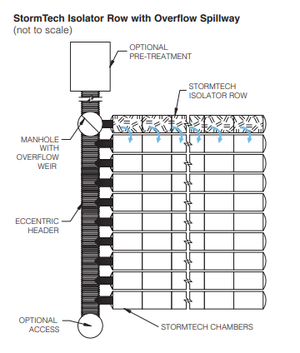
Pretreatment - Above ground and below grade storage and settling devices

Above ground and below grade storage and settling systems are typically below grade vaults, specialized structures, or similar practices that are designed to promote gravitational settling in a liquid-filled system. These devices may also be outfitted with additional structures to also trap trash, oil, and other floatables. The devices presented below are a mix of proprietary and nonproprietary systems. The proprietary entries are examples that utilize one or more of the nonproprietary functionalities. Manholes with sumps have the space underneath the manhole’s lowest outlet (the sump) for sediment and debris collection and storage. The practice itself is nonproprietary, though proprietary outlet structures are available for enhanced performance.
Forebays are small bodies of water positioned just upstream of a larger pretreatment or treatment area. They slow the water allowing for settling of larger sediment. While these can be installed in front of vegetative filter strips, ponds, or other practices, each of which maintains its own specifications and recommendations, the forebays in this table are examples of the most common and general applications.
Contents
System Design
The underground settling vaults often come in pre-cast sizes from the manufacturer as an alternative to designing a custom unit. This is often a cost-effective approach with the designer selecting a larger size if manufacturer does not have the exact size based on calculations or sizing tables. Design and sizing tables may be available on a manufacturer’s website and are often accessible through the hyperlinks.
For forebays, the design is most often based on required capacity. Other specifications such as those listed under “Materials” often help to make maintenance easier.
System and Component Sizing
The sizing of an underground settling system can be estimated using various tools, formulae, or guidance documents. Most manufacturers have a tool or calculator for determining the size of device that may be needed, however modeled flow rates or the rational equation can be used to estimate the runoff flow rates. Additionally, guidance from the State of New Jersey Department of Environmental Protection and Washington State Department of Ecology provide additional considerations based on performance of these devices. Many sumped manholes can also use SHSAM (Sizing Hydrodynamic Separators And Manholes) for predicting the amount of suspended sediments removed from stormwater runoff over a given period of time. SHSAM is comprised of a continuous runoff model and sediment removal responses to predict the removal efficiency of the device. Most important for the sizing is the anticipated frequency of operation and maintenance as well as the protection of downstream BMPs and receiving waters.
Specifically regarding forebays, the capacity is determined by the flow received from its impervious drainage area. Then the shape of the basin and positioning of its inlets and outlets ensure that adequate settling occurs. Some devices have “enhancements” that can provide treatment mechanisms beyond the primary pretreatment mechanism. These can provide an additional level of treatment such as filtration, skimming (in addition to settling or screening), chemical treatment/sorption, or biodegradation. This is denoted by the Y or N in the table indicating this ability to perform additional mechanisms.
Links to tables with information on above ground and below grade storage and settling
Below are links to several tables containing information on above ground and below grade storage and settling. To see all tables on a single page, link here.
- Above ground and below grade storage and settling - pollutant removal information
- Above ground and below grade storage and settling - system design information
- Above ground and below grade storage and settling - system and component sizing
- Above ground and below grade storage and settling - installation and maintenance recommendations
Related pages
- Pretreatment selection tool
- Overview and methods of pretreatment
- Overviews for different types of pretreatment practices
- Information for specific types of pretreatment practices
- Design, construction, operation and maintenance specifications for pretreatment vegetated filter strips
- Pretreatment - Hydrodynamic separation devices
- Pretreatment - Screening and straining devices, including forebays
- Pretreatment - Above ground and below grade storage and settling devices
- Pretreatment - Filtration devices and practices
- Pretreatment - Other pretreatment water quality devices and practices
- To see the above pages as a single page, link here
Pretreatment sizing for basins and filters strips
Guidance for managing sediment and wastes collected by pretreatment practices
Tables
- Pretreatment tables - link to tabled information for pretreatment practices
- Hydrodynamic separator tables
- Screening and straining devices tables
- Above ground and below grade storage and settling tables
- Filtration tables
- Other water quality devices tables
Other information and links
This page was last edited on 5 December 2022, at 23:42.
